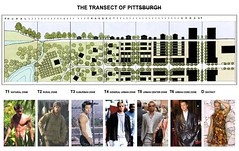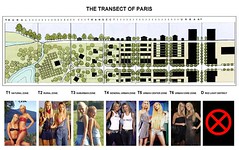A new take on "Cosmopolitan" with updated Graphic explanation of the new urban transect
Andres Duany is a serious guy with a great deal of commitment and drive. I don't know him well enough to be able to say anything about his sense of humor, but I see an appreciation for irony and understatement given these two recent images he has created to better explain the development transect and the appropriateness of style and building design according to the "T" or "transect" zone represented.


From New Urban News
Transect applied to regional plans: Rural-urban categorization system is touted as effective in coding, education, and design.
The Transect, a new model for planning and coding the New Urbanism, is beginning to be employed in regional planning. Duany Plater-Zyberk & Company (DPZ) recently used the Transect as the basis to create a plan and code for Onondaga County, New York, which includes the City of Syracuse and surrounding suburbs, villages, and countryside. A regional planning effort by Torti Gallas & Partners, completed in March, 2000, was based entirely on the Transect.
Developed by Andres Duany and DPZ, the Transect is a categorization system that organizes all elements of the urban environment on a scale from rural to urban. Its potential lies in: 1) Education (it is easy to understand); 2) Coding (it can be directly translated into zoning categories); 3) Creating “immersive environments.” An immersive environment is one where all of the elements of the human environment work together to create something that is greater than the sum of the parts.
The Transect has six zones, moving from rural to urban. It begins with two that are entirely rural in character: Rural preserve (protected areas in perpetuity); and Rural reserve (areas of high environmental or scenic quality that are not currently preserved, but perhaps should be).
The transition zone between countryside and town is called the Edge, which encompasses the most rural part of the neighborhood, and the countryside just beyond. The Edge is primarily single family homes. Although Edge is the most purely residential zone, it can have some mixed-use, such as civic buildings (schools are particularly appropriate for the Edge). Next is General, the largest zone in most neighborhoods. General is primarily residential, but more urban in character (somewhat higher density with a mix of housing types and a slightly greater mix of uses allowed).
At the urban end of the spectrum are two zones which are primarily mixed use: Center (this can be a small neighborhood center or a larger town center, the latter serving more than one neighborhood); and Core (serving the region — typically a central business district). Core is the most urban zone.
“The “Transect zoning” concept should be the new paradigm for local land-use regulations, not the least of all because it can be implemented through the familiar legal framework of Euclidian zoning districts,” says Bill Spikowski, a planner in Fort Myers, Florida, who has applied Transect concepts in his collaborative work with Dover Kohl & Partners. “This time around, though, the zoning districts should be keyed to the desired Transect zones (edge, general, center, and core), plus those unavoidable, auto-dominated zones for heavy industry and big boxes.”
Duany, who previously put forward the Lexicon of the New Urbanism as a universal standard for designing neighborhoods and towns, has since changed his mind. He now touts the Transect, originally embedded in The Lexicon, as the true standard. “I am convinced that the Transect will do the job, not The Lexicon as we thought,” he says. “The Lexicon has advocates, but I have come to realize that it is wrong. The Lexicon is too specific and complete to be a standard. The real matrix, I believe, is the Transect.”
___________
Building types, not just what to wear, ought to be guided by the transect concept. That means in urban areas, planning and building centered around walking and the pedestrian, not for the car. The Carytown street in a blog entry from yesterday is urban, and the H Street Connection photo in the blog entry from April 9th on Skyland is a suburban (T-3/T-4) development type in a T-5 zone.
For more information about new urbanism, check out the Congress for the New Urbanism website as well as the website for the local chapter for the DC region (which has an interesting program coming up on Saturday May 14th).



1 Comments:
here to help you learn the ins and outs of payday advances and Payday Loans Guaranteed, how they work, and what to watch out for when you’re shopping for one, whether it’s online or in person. Read on, and find out how
Post a Comment
<< Home